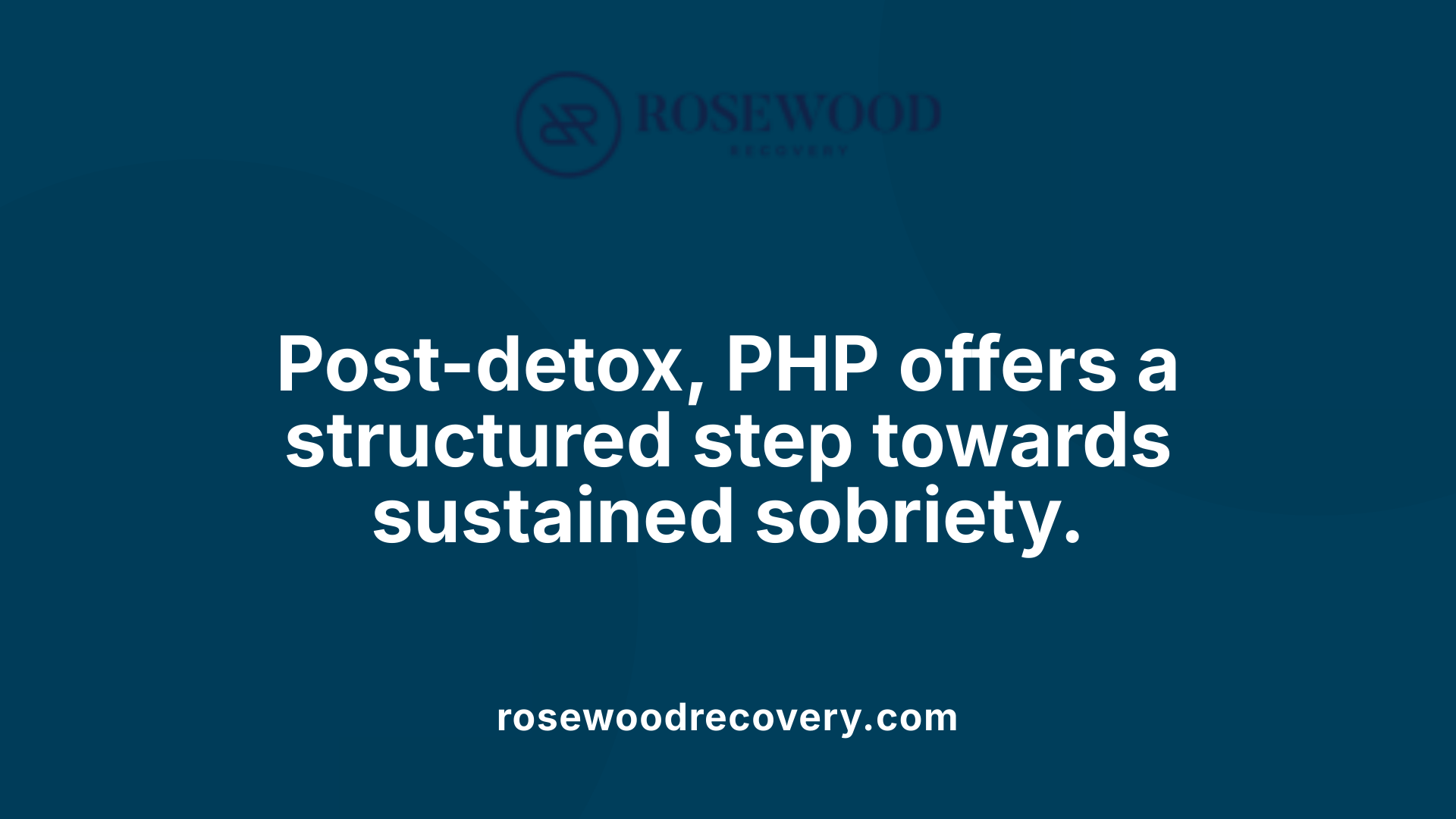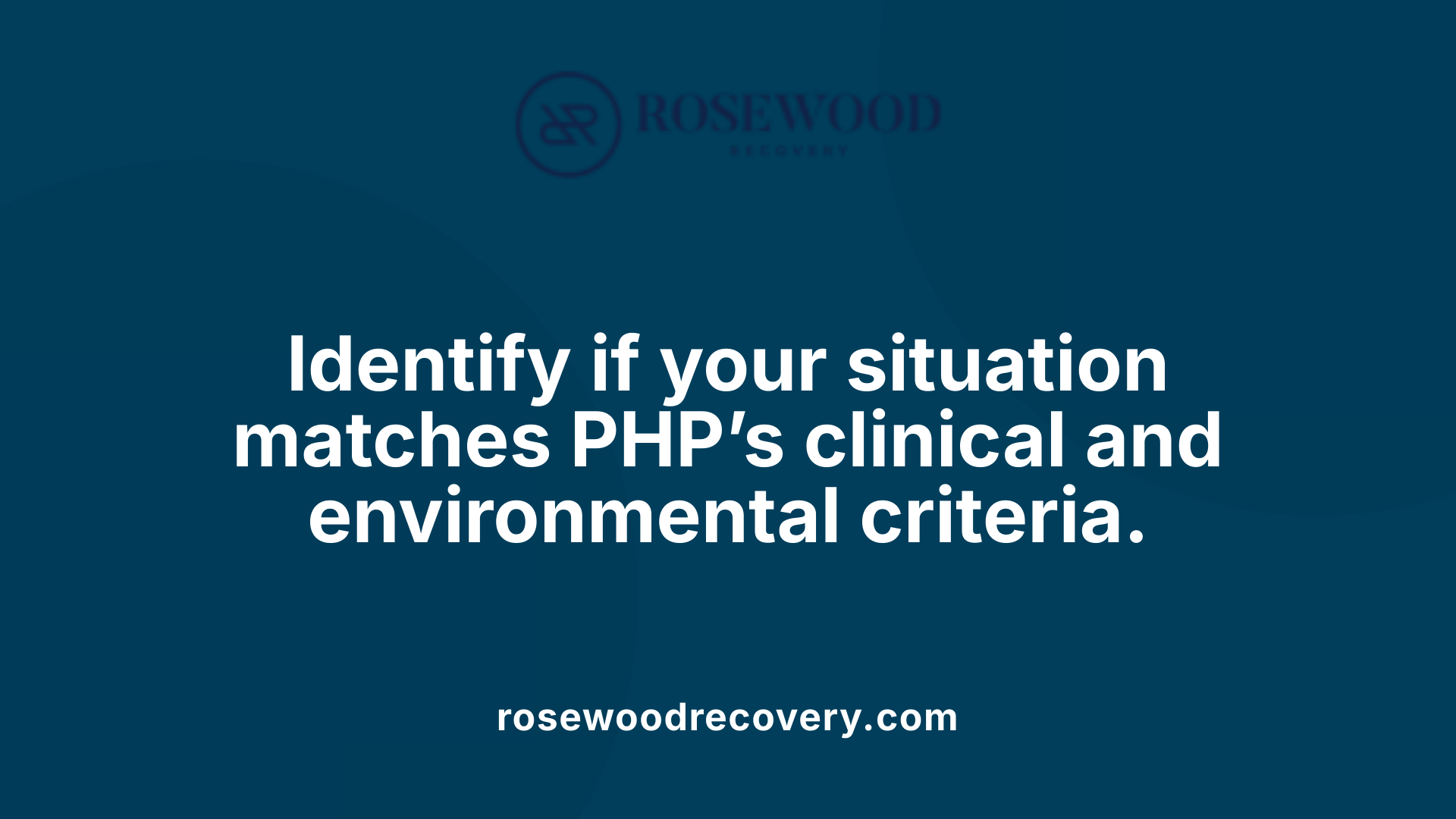When is PHP the right level of care for addiction
Understanding the Role of Partial Hospitalization in Addiction Recovery

Deciphering the Appropriate Use of PHP for Addiction Treatment
Choosing the right level of care is crucial for successful addiction recovery. Partial hospitalization programs (PHPs) strike a balance between inpatient and outpatient care, offering intensive support without full hospitalization. This article explores when PHP is appropriate, its benefits, and how it compares to other treatment options, helping clinicians, patients, and families make informed decisions.
What Does a Partial Hospitalization Program (PHP) Entail?

Overview of PHP structure and services
A Partial Hospitalization Program (PHP) is a structured treatment option designed for individuals who require more support than outpatient services but do not need full inpatient care. PHPs combine various therapeutic approaches with medical oversight to foster recovery from mental health or substance use issues.
Participants in PHPs typically engage in a range of services including individual therapy, group therapy, medication management, and educational sessions. These programs offer a comprehensive, multidisciplinary approach, ensuring that patients receive mental health support, medical monitoring, and skills training such as relapse prevention and coping strategies.
The environment emphasizes consistency and routine, providing patients with a safe space to work through their challenges while maintaining their daily routines outside of treatment hours.
Typical schedule and duration
Sessions in a PHP generally last between 4 to 6 hours per day, five days a week. This intense schedule helps establish a structured daily routine, reinforcing positive habits and reducing the risk of relapse.
PHP durations vary, often lasting several weeks to months, depending on individual needs and progress. The program’s intensity allows for a focused approach to treatment, fostering significant progress within a relatively short period.
This schedule affords individuals the opportunity to continue working, attending school, and managing family responsibilities, making it a flexible yet intensive treatment option.
Multidisciplinary treatment components
A PHP provides a broad spectrum of treatment components designed to support recovery.
- Individual Therapy: Focused sessions helping patients address personal issues, set goals, and work through emotional challenges.
- Group Therapy: Facilitates peer support, builds social skills, and fosters a sense of belonging, which helps reduce feelings of isolation.
- Medication Management: Regular monitoring and adjustments of medication to ensure safety and effectiveness.
- Educational Sessions: Teach relapse prevention, coping skills, and strategies for managing triggers.
- Crisis Intervention: Immediate support and stabilization in case of emergencies.
Including medical oversight ensures safety and tailored treatment, especially for those with co-occurring disorders or severe conditions.
How does partial hospitalization compare to inpatient or outpatient treatment in terms of suitability?
Partial hospitalization programs (PHPs) serve as a balanced treatment option positioned between inpatient care and outpatient services. They are ideal for individuals who need a structured, supportive environment for recovery but do not require 24-hour supervision.
Compared to inpatient treatment, PHPs are less restrictive and allow patients to live at home, maintaining their daily routines and responsibilities. This setting encourages independence while providing intensive support, making it especially suitable for those transitioning from inpatient care or needing more structured care than outpatient programs offer.
In contrast to outpatient (IOP) services, which typically involve shorter sessions (around 3 hours) and fewer days per week, PHPs involve longer daily sessions and more comprehensive treatment, often several weeks in duration. IOPs are often favored for less severe cases or as step-down programs after PHPs.
Overall, PHPs fill the gap by offering a high level of care that is flexible enough to integrate into everyday life, supporting sustained recovery and reintegration into the community. They are best suited for individuals with moderate to severe symptoms who are motivated to recover and have stable living environments.
This blend of structure, intensive support, and independence makes PHPs a highly effective treatment option for many individuals facing mental health or substance use challenges.
When Is PHP the Right Level of Care for Addiction?

What are the criteria for determining if a PHP is suitable?
A Partial Hospitalization Program (PHP) is an appropriate treatment option for individuals who need substantial therapeutic support but do not require full-time inpatient supervision. These individuals typically have moderate to severe addiction or mental health challenges that demand structured, intensive care. They should have a stable home environment and a support system capable of helping maintain recovery outside the treatment facility.
PHPs provide a comprehensive treatment approach, including therapy, medication management, and skill-building workshops, often for several weeks. The program's structured daily schedule, usually lasting 4 to 6 hours per day, five days a week, helps foster routine and positive habits.
Most suitable candidates are motivated for recovery and can balance treatment with their daily responsibilities such as work, school, or family commitments. Additionally, they benefit from crisis intervention and medical oversight, making PHP especially beneficial for those transitioning from inpatient treatment or detox.
Can PHP be used immediately after detoxification?
Yes, PHP is frequently recommended immediately following detoxification, especially for individuals with moderate to severe substance use disorders. Detox safely manages withdrawal symptoms with medical supervision, stabilizing patients before they begin longer-term treatment.
Post-detox, PHP offers the structured care needed to maintain abstinence and address co-occurring mental health issues. The program involves around 20 hours of therapy and support services weekly, spanning approximately 1 to 2 weeks.
This phase helps strengthen coping strategies, reduce relapse risk, and prepare individuals for continued outpatient care. It provides a bridge from detox to less intensive outpatient programs, ensuring seamless continuity of care.
How does PHP compare to other levels of care?
| Level of Care | Duration & Intensity | Typical Services | Suitable For |
|---|---|---|---|
| Detox | 24/7 medical supervision, 3-7 days | Withdrawal management | Immediate stabilization of withdrawal symptoms |
| Inpatient Care | 24/7 live-in support, weeks to months | Therapy, medication, recreational activities | Severe addiction, co-occurring disorders |
| PHP (Partial Hospitalization) | 4-6 hours/day, 5 days/week | Therapy, medication management, skill building | Moderate to severe cases needing structured support |
| IOP (Intensive Outpatient) | 3 hours/day, 3-5 days/week | Therapy, relapse prevention | Less severe cases, outpatient transition |
| OP (Outpatient) | 1-2 hours, 2-3 days/week | Counseling, support groups | Mild cases or post-treatment continuation |
What makes PHP a bridge between inpatient and outpatient treatments?
PHPs provide a level of care more intensive than typical outpatient programs but less restrictive than inpatient settings. They are ideal for people who need ongoing support but can live at home.
This structure allows individuals to receive professional help and crisis intervention while maintaining daily routines. It also addresses the complex needs of those with significant substance use or mental health issues by offering continuous medical and therapeutic support.
Overall, PHP serves as a crucial intermediate step for sustained recovery, especially during transition phases post-inpatient care or detox.
Is PHP suitable for all individuals with addiction?
While PHP offers many benefits, it is best suited for motivated individuals with a stable environment who require intensive, structured treatment. Those with unstable housing, active substance use without readiness for change, or severe psychiatric conditions might require more intensive, monitored inpatient care.
Family involvement and a strong support system can significantly enhance the success of PHP. Given its demands, participants must be committed to actively engaging in daily therapy sessions and adhering to treatment plans.
In summary, PHP fills an important niche in addiction treatment. It offers a balanced approach that combines the benefits of rigorous therapy and medical oversight with the flexibility to live at home and continue personal responsibilities.
Overview of PHP placement within ASAM criteria levels of care
| Level of Care | Description | Weekly Treatment Hours | Ideal For |
|---|---|---|---|
| Level 0.5 | Early intervention | Less than 9 hours | Preventative or mild cases |
| Level I | Outpatient | Up to 9 hours | Mild SUD, supportive environment |
| Level II | Intensive outpatient/Partial hospital | 20+ hours | Moderate to severe SUD needing active treatment |
| Level III | Residential/Inpatient | 24/7 care | Severe symptoms or co-occurring disorders |
| Level IV | Medically managed intensive inpatient | Full medical intervention | Critical health stabilization |
Understanding these different treatment levels helps match individuals with the most appropriate care, ensuring effective recovery pathways.
Effectiveness and Benefits of PHP in Recovery
What are the benefits and effectiveness of partial hospitalization programs in addiction recovery?
Partial hospitalization programs (PHPs) are a highly valued option in addiction treatment. They combine intensive therapeutic support with the flexibility to live at home, making them both effective and practical. PHPs typically include a rigorous schedule of therapy, such as individual counseling, group therapy, and educational workshops, lasting several weeks.
One of the main strengths of PHPs is their role in providing comprehensive care. They incorporate medical oversight, medication management, crisis intervention, and relapse prevention strategies. This multidisciplinary approach ensures that individuals receive holistic support tailored to their mental health and substance use needs.
Research indicates that PHPs significantly improve recovery outcomes. Participants benefit from structured routines, which reinforce healthy habits and reduce the chances of relapse. The supportive environment fostered through group therapy helps individuals feel less isolated, strengthening their motivation to recover.
Furthermore, PHPs serve as a bridge between inpatient treatment and outpatient programs. They are often used during the early to middle stages of recovery, offering a balance of intensive care and independence. This transition period is crucial for developing the skills and stability needed for long-term sobriety.
Compared to less intensive outpatient programs, PHPs provide more comprehensive services, including 24/7 medical oversight if necessary. They are also more cost-effective than inpatient rehab, offering quality care without requiring full residential commitment.
The inclusion of peer support, family involvement, and aftercare planning enhances the overall effectiveness of PHPs. These elements create a network of accountability and emotional support, which are vital for sustaining recovery.
Overall, PHPs are a flexible, evidence-based treatment option that significantly boosts the chances of successful, lasting recovery for individuals battling substance use disorders.
At which stages of the recovery process is partial hospitalization most effective?
Partial hospitalization programs are particularly effective during the early to middle phases of recovery. They are designed to support individuals who are transitioning from inpatient care or detoxification. During this stage, patients often need more structured support than outpatient services can provide but do not require 24-hour supervision.
Typically lasting from four to six weeks, PHPs serve as a stabilization period that helps individuals develop essential recovery skills. They are especially beneficial for those with moderate substance use issues, co-occurring mental health conditions, or a history of relapse.
The structured schedule of PHPs, which includes therapy, medical monitoring, and skill-building workshops, helps individuals establish routines and accountability. It also offers an environment to address any behavioral health concerns simultaneously, which is common in cases of dual diagnosis.
This stage of treatment acts as a bridge, preparing individuals for more independent outpatient care and supporting long-term sobriety. By developing relapse prevention strategies in a controlled setting, patients increase their resilience to triggers outside the program.
The duration of PHP participation varies based on individual needs, severity of issues, and progress. Many spend several weeks to months in the program before transitioning to less intensive outpatient services.
In summary, PHPs are an effective stabilizing treatment during the critical transition phase, helping individuals gain independence while still receiving necessary supports to prevent relapse.
Criteria and Indicators for PHP Use

What conditions or circumstances make a person suitable for partial hospitalization as opposed to inpatient or outpatient care?
Partial hospitalization programs (PHPs) are designed for individuals who require a level of care that is more intensive than outpatient services but less restrictive than full-time inpatient treatment. Suitable candidates are generally those with moderate severity of mental health or addiction symptoms.
They should be medically stable, meaning they can manage their health condition without the need for constant medical supervision. Such individuals are capable of actively engaging in rigorous therapy sessions, including individual and group therapy, medication management, and educational workshops.
Having a safe and supportive home environment is critical to ensure the continuation of treatment outside the facility. This setting allows individuals to maintain their independence while adhering to their treatment plan.
Motivation for recovery and some level of functional stability are also prerequisites. The individual’s history should indicate that less intensive outpatient care may not be enough, but inpatient hospitalization may be unnecessary or overly restrictive.
A thorough assessment by healthcare professionals evaluates whether a person’s clinical needs, treatment history, and psychosocial circumstances align with the requirements of PHP.
What criteria or indicators suggest that partial hospitalization is an appropriate treatment option?
Indicators of suitability include the severity and stability of the individual’s condition. For example, someone who has managed withdrawal symptoms effectively and does not require constant medical supervision is a good candidate.
The ability to function independently enough to attend therapy sessions and follow treatment plans is essential. The individual should demonstrate motivation and readiness to actively participate in their recovery process.
Supportive factors such as a stable residence, reliable transportation, and a strong support system at home can enhance the effectiveness of PHP.
Safety concerns, high immediate relapse risk, or unstable living conditions generally preclude PHP as an appropriate choice.
In summary, PHP is often recommended for those transitioning from inpatient care or needing an intermediate step to prevent relapse, provided they meet these clinical and environmental criteria.
Can PHP be a standalone treatment or does it require other care levels?
How does PHP fit into the broader spectrum of addiction and mental health treatment?
Partial Hospitalization Programs (PHPs) serve an important role in the continuum of care for individuals with behavioral health conditions. They are designed to strike a balance between intensive support and the independence of outpatient treatment.
While PHPs offer a comprehensive range of services—such as individual therapy, group counseling, medication management, and educational workshops—they are often part of a broader treatment plan tailored to each person's needs. This means that PHPs can sometimes function as a standalone option, particularly for those who have stabilized enough to live at home but still require frequent clinical support.
However, PHPs are also frequently integrated with other care levels. For example, a person might begin treatment with inpatient hospitalization to manage severe symptoms or a crisis. After stabilization, they transition into a PHP to focus on recovery skills while living at home.
Similarly, for mild to moderate cases, PHPs might serve as a step down from inpatient care, helping individuals maintain progress and prevent relapse. Conversely, for extremely severe substance use disorders, PHPs are often combined with medical monitoring, detoxification, or residential inpatient care to ensure safety and efficacy.
Is PHP a part of broader treatment plans?
Yes, PHPs are typically embedded within comprehensive plans that include multiple levels of care. Coordinating treatment across different services ensures that individuals receive the appropriate intensity of support at different stages of recovery.
This approach promotes ongoing engagement, reduces the risk of relapse, and sustains long-term recovery success. Family involvement, ongoing outpatient services, and aftercare planning are often incorporated into PHP-based strategies.
What are the benefits of integrating PHP with other treatments?
Integrated care allows for flexibility and personalization—matching treatment intensity to the evolving needs of the individual.
- It provides continuous support as patients progress through different recovery phases.
- It reduces the risk of gaps in care that can lead to setbacks.
- It enables a layered approach, addressing medical, psychological, and social aspects of recovery.
- It enhances the likelihood of sustained recovery by reinforcing skills gained in PHP and other therapies.
Overall, while PHP can serve as a standalone program for some, its greatest benefit is often realized when it is part of a broader, coordinated treatment plan that includes various levels of care tailored to individual needs.
Making an Informed Choice in Addiction Treatment
Selecting the appropriate treatment level, including PHP, depends on individual needs, severity of symptoms, support systems, and recovery goals. PHP offers a compelling middle ground for those requiring structured support without full hospitalization, facilitating medication management, therapy, and relapse prevention while enabling individuals to maintain daily life. By understanding the criteria, benefits, and timing for PHP, patients and clinicians can make informed decisions that promote sustainable recovery and well-being. As research continues to evolve, PHP remains a vital component of comprehensive addiction treatment, capable of bridging inpatient care and outpatient services.
References
- When Should You Consider a Partial Hospitalization ...
- Benefits of a PHP for Substance Abuse
- Levels of Care for Addiction Treatment
- Knowing What Level of Care Is Right in Addiction Recovery
- Comparing Levels of Care: PHP, IOP, and OP
- When Should You Consider a Partial Hospitalization ...
- When to Opt for a Partial Hospitalization Program
- Providing Crisis-oriented and Recovery-based Treatment ...
- Benefits of a PHP for Substance Abuse
- Providing Crisis-oriented and Recovery-based Treatment ...
More Articles
Recovery Begins Here
Click below to get in touch and schedule a consult call with our team to begin your journey towards happiness and freedom.
Rosewood Recovery does not discrimate against any person because of the race, color, religious creed, ancestry, age, sex, sexual orientation, gender identity, national origin, handicap or disability or the use of a guide or support animal because of the blindness, deafness or physical handicap.


.jpeg)


